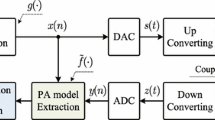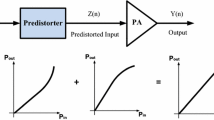Abstract
To improve the accuracy of the nonlinear distortion correction for the radio frequency (RF) power amplifier (PA), it is necessary to precisely obtain the reverse function of the PA nonlinear model. However, the direct inversion of the PA nonlinear model involves solving a high-order univariate polynomial, which is difficult to apply in engineering. In this study, based on the envelope memory polynomial (EMP) model, the high-order terms of the nonlinear model are approximated by their previously calculated values through iterations and considered as known constants in the polynomial solution finding process, thereby resulting in a significant reduction in computational complexity. Compared with the direct inversion method, model of a 9th-order nonlinear, the proposed method reduces the calculation time in the coordinated rotation digital computer (CORDIC) algorithm by at least 80%. The simulation results show that for a long-term evolution (LTE) downlink signal, the results obtained by the proposed simplified method agree well with those obtained by direct inversion method.
Similar content being viewed by others
References
Guo Y C, Tang J L, Wu G, et al. Power allocation for massive MIMO: impact of power amplifier efficiency. Sci China Inf Sci, 2016, 59: 022301
Guan N, Wu N, Wang H. Digital predistortion of wideband power amplifier with single undersampling ADC. IEEE Microw Wirel Compon Lett, 2017, 27: 1016–1018
Ding L, Mujica F, Yang Z. Digital predistortion using direct learning with reduced bandwidth feedback. In: Proceedings of 2013 IEEE MTT-S International Microwave Symposium Digest (MTT), Seattle, 2013. 1–3
Abdelaziz M, Anttila L, Kiayani A, et al. Decorrelation-based concurrent digital predistortion with a single feedback path. IEEE Trans Microw Theory Tech, 2018, 66: 280–293
Braithwaite R N. Digital predistortion of an RF power amplifier using a reduced volterra series model with a memory polynomial estimator. IEEE Trans Microw Theor Tech, 2017, 65: 3613–3623
Hammi O, Ghannouchi F M, Vassilakis B. A compact envelope-memory polynomial for rf transmitters modeling with application to baseband and RF-digital predistortion. IEEE Microw Wirel Compon Lett, 2008, 18: 359–361
Mkadem F, Islam A, Boumaiza S. Multi-band complexity-reduced generalized-memory-polynomial power-amplifier digital predistortion. IEEE Trans Microw Theor Tech, 2016, 64: 1763–1774
Kim Y H, Do Jo G, Oh J H, et al. An efficient simplified behavioral model for RF power amplifiers. In: Proceedings of IEEE Topical Conference on Power Amplifiers for Wireless and Radio Applications, Phoenix, 2011. 65–68
Pan W, Liu Y, Tang Y. A predistortion algorithm based on accurately solving the reverse function of memory polynomial model. IEEE Wirel Commun Lett, 2012, 1: 384–387
Liu Y, Pan W, Shao S, et al. A new digital predistortion for wideband power amplifiers with constrained feedback bandwidth. IEEE Microw Wirel Compon Lett, 2013, 23: 683–685
Li L M, Billings S A. Estimation of generalized frequency response functions for quadratically and cubically nonlinear systems. J Sound Vib, 2011, 330: 461–470
Safari N, Roste T, Fedorenko P, et al. An approximation of volterra series using delay envelopes, applied to digital predistortion of RF power amplifiers with memory effects. IEEE Microw Wirel Compon Lett, 2008, 18: 115–117
Kim J, Konstantinou K. Digital predistortion of wideband signals based on power amplifier model with memory. Electron Lett, 2001, 37: 1417–1418
Kim J, Konstantinou K. Method and apparatus for calculating the predistortion function from a power amplifier. US Patent, 6498529, 2002–12-24
Szidarovszky F, Yakowitz S J. Principles and Procedures of Numerical Analysis. New York: Springer, 1978. 141–178
Lang M, Frenzel B C. Polynomial root finding. IEEE Signal Process Lett, 1994, 1: 141–143
Kim H S, Zhu W, Bhatia J, et al. A practical, hardware friendly MMSE detector for MIMO-OFDM-based systems. Eurasip J Adv Sig Proc, 2008, 2008: 1–14
Acknowledgements
This work was supported in part by National Natural Science Foundation of China (Grant Nos. 61771107, 61701075, 61771115, 61531009, 61471108), National Major Projects (Grant No. 2016ZX03001009), the Project Funded by China Postdoctoral Science Foundation, and the Fundamental Research Funds for the Central Universities.
Author information
Authors and Affiliations
Corresponding author
Rights and permissions
About this article
Cite this article
Ma, W., Quan, X., Zhao, B. et al. An enhanced digital predistortion algorithm based on polynomial model identification. Sci. China Inf. Sci. 62, 22304 (2019). https://doi.org/10.1007/s11432-017-9420-y
Received:
Revised:
Accepted:
Published:
DOI: https://doi.org/10.1007/s11432-017-9420-y




